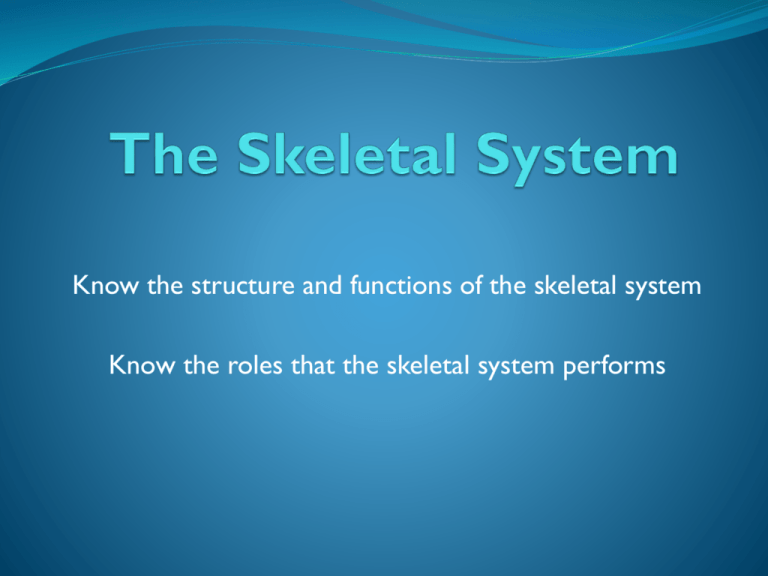The Skeletal System - St John's, Marlborough
advertisement

Know the structure and functions of the skeletal system Know the roles that the skeletal system performs Functions of the skeletal system With a partner discuss the functions of your skeleton. How many of the 5 functions can you identify? Movement at joints Support for muscles and vital organs Shape Protection such as skull protecting the brain Blood-cell production in the bone marrow The Skeleton Name the numbered bones: A)1 B)3 C)4 D)7 E) 10 F) 11 G)12 H)15 I) 18 J) 19 Total – 10 marks Test your knowledge Cranium = 5 Fibula = 9 Sternum = 7 Femur = 4 Complete the following calculation: Shin bone Plus Thigh bone Minus Skull Multiplied by Kneecap Dividied by Breastbone = ????? And the answer is………3 Bones Long Bones Short Bones Such as the femur Such as the metacarpals Flat Bones (Plate bones) Irregular Bones Such as the cranium Such as the vertebrae Joints Movement can only happen when the skeletal system is joined by the muscular system All movement occurs at Joints, which is where 2 (or more) bones meet Joints are classified according to how much movement they allow... Freely moveable or Synovial Slightly moveable (Vertebrae in your spine) Immoveable or fixed (Many bones in the Skull) We are mostly concerned with Synovial joints since they allow more movement... Hinge- Elbow and Knee Ball and Socket- Hip and Shoulder Pivot- Radio-ulnar joint Saddle- Thumb Gliding- Hand Condyloid- Wrist Connective tissue Tendons, ligaments and cartilage play an important role in all joints. Do you know the difference between them? Tendons Very strong, non-elastic cords Join muscle to bone Ligaments Bands of fibre attached to bones Keep the joint stable Cartilage Tough but flexible tissue Acts as a buffer between bones Movement Considered to be the main role of the skeletal system There are specific names given to specific movements... Flexion- decreasing of an angle at a joint Extension- increasing of an angle at a joint Abduction- movement of limb away from midline of body Adduction- movement of limb towards midline of body Rotation- movement of limb freely in a curve Name as many types of movement as you can in each photo Test your knowledge Cover your notes from the lesson and try these…. State 4 of the functions of the skeletal system. (4 marks) Name 3 bones which are located in your leg. (3 marks) Name the 4 different ‘types’ of bone. (4 marks) Which word, beginning with an S, describes joints which allow movement? (1 mark) What types of joint is found at the elbow and the hip? (2 marks) State a difference between tendons and ligaments. (1 mark) A bicep curl would involve which type of movement at the elbow joint? (1 mark) Total = 16 marks 8 or less = more revision needed! 9-12 = a good effort 12-15 = working to an A standard! 16 = totes amazeballs!!!




